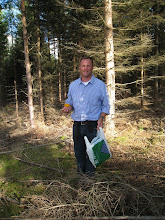 This barley was planted on October 13, 2010 in Northern Virginia. The photo at left was taken seven days after planting and shows barley shoots emerging from the ground. The weather ranged from 49 degrees (overnight) to about 75 degrees during this period. It rained once, the day after I planted. I also watered using a sprinkler one time on about day 6. Birds and squirrels were remarkably kind to the barley this year with very little predation. The dog has been spotted walking through the plot and I just found my 7 year-old son Gunnar's soccer ball in the plot, but overall it is doing well. At this stage it is very resilient. Later, when it has heads of barley, it is prone to lodging (falling over, getting the heads wet, and getting ruined). If you look closely on the far left of the photo, in the middle, you can see a grain that has spindly white roots projecting (called acrospires).
This barley was planted on October 13, 2010 in Northern Virginia. The photo at left was taken seven days after planting and shows barley shoots emerging from the ground. The weather ranged from 49 degrees (overnight) to about 75 degrees during this period. It rained once, the day after I planted. I also watered using a sprinkler one time on about day 6. Birds and squirrels were remarkably kind to the barley this year with very little predation. The dog has been spotted walking through the plot and I just found my 7 year-old son Gunnar's soccer ball in the plot, but overall it is doing well. At this stage it is very resilient. Later, when it has heads of barley, it is prone to lodging (falling over, getting the heads wet, and getting ruined). If you look closely on the far left of the photo, in the middle, you can see a grain that has spindly white roots projecting (called acrospires).Twelve days after planting (Oct. 25, 2010). The barley below is about three inches high and looking good. As you can see from the photo below (taken the same day) the barley comes up a bit unevenly. There are barley plants in the browner sections, just not as many as elsewhere. This is OK, because the barely will "tiller" -- put off side shoots which will become barley plants that will also produce grain. This barley still probably has three to four weeks of good weather here in Northern Virginia to grow before going essentially dormant for most of the winter (when the weather goes below 50 degrees -- we will have warm snaps occasionally throughout the winter where the barely will seem to be growing again).
It is this relatively mild weather that allows us to plant "winter" barley here in Virginia, as opposed to "spring" barley, which is planted in early spring in areas experiencing colder climates (i.e., upper midwest, the source for much of the US's malting barley). Many of the most famous and high-quality ale malts, like Maris Otter, are two-row winter sown. As far as I know, there is essentially no two-row winter malting barley grown in the United States.

























